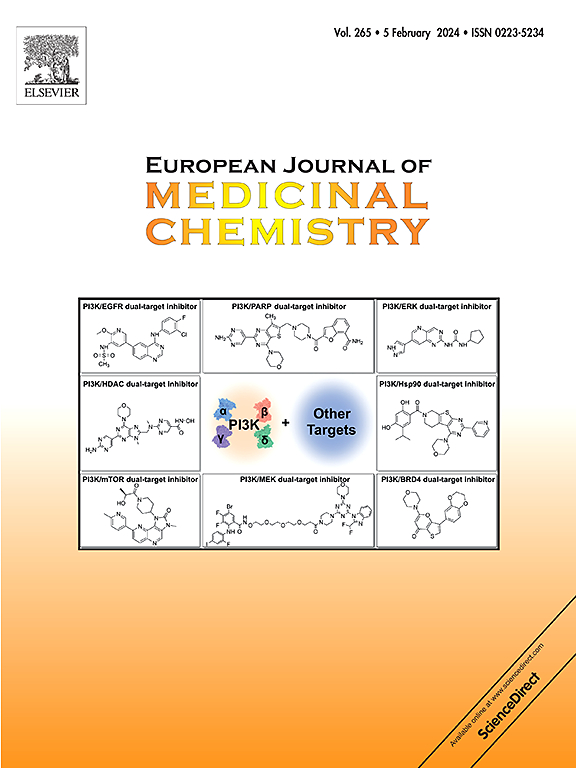Discovery of 2,4-dianilinopyrimidine derivatives as novel p90 ribosomal S6 protein kinase (RSK) inhibitors
IF 6
2区 医学
Q1 CHEMISTRY, MEDICINAL
引用次数: 0
Abstract
RSK, or p90 ribosomal S6 kinase, plays a crucial role in tumor cell proliferation and survival, making it an appealing target for cancer therapies. With the aim to explore novel RSK inhibitors as anticancer agents, a series of 2,4-dianilinopyrimidine derivatives 2b–2n and 3a–3n have been designed and synthesized. Among them, compound 3e displayed substantial kinase inhibitory activity against RSK2 (IC50 = 37.89 ± 3.08 nM) and a potent antiproliferative effect against a range of cell lines, including HeLa, MIA PaCa-2, U937, SW620, HT-29, AGS, and two kinds of EGFR mutant cells (IC50s = 0.189–0.572 μM). Additionally, compound 3e exhibited a high affinity for RSK and effectively inhibited RSK activity in HeLa cells. It triggered significant apoptosis and caused cell cycle arrest in the G2/M phase. Moreover, 3e displayed considerable in vivo anticancer activity while maintaining an acceptable safety profile. These findings imply that compound 3e, featuring a 2,4-dianilinopyrimidine scaffold, could serve as a promising RSK inhibitor for cancer treatment.


发现2,4-二苯胺嘧啶衍生物作为新型p90核糖体S6蛋白激酶(RSK)抑制剂
RSK或P90核糖体S6激酶在肿瘤细胞增殖和存活中起着至关重要的作用,使其成为癌症治疗的一个有吸引力的靶点。为了探索新的RSK抑制剂作为抗癌药物,设计并合成了一系列2,4-二胺嘧啶衍生物2b-2n和3a-3n。其中,化合物3e对RSK2表现出明显的激酶抑制活性(IC50 = 37.89±3.08 nM),对HeLa、MIA PaCa-2、U937、SW620、HT-29、AGS和两种EGFR突变细胞(IC50 = 0.189 ~ 0.572 μM)均有明显的抗增殖作用。此外,化合物3e对RSK具有高亲和力,可有效抑制HeLa细胞中的RSK活性。在G2/M期引起细胞凋亡和细胞周期阻滞。此外,3e在保持可接受的安全性的同时显示出相当大的体内抗癌活性。这些发现表明,化合物3e具有2,4-二苯胺嘧啶支架,可以作为一种有希望的癌症治疗RSK抑制剂。
本文章由计算机程序翻译,如有差异,请以英文原文为准。
求助全文
约1分钟内获得全文
求助全文
来源期刊
CiteScore
11.70
自引率
9.00%
发文量
863
审稿时长
29 days
期刊介绍:
The European Journal of Medicinal Chemistry is a global journal that publishes studies on all aspects of medicinal chemistry. It provides a medium for publication of original papers and also welcomes critical review papers.
A typical paper would report on the organic synthesis, characterization and pharmacological evaluation of compounds. Other topics of interest are drug design, QSAR, molecular modeling, drug-receptor interactions, molecular aspects of drug metabolism, prodrug synthesis and drug targeting. The journal expects manuscripts to present the rational for a study, provide insight into the design of compounds or understanding of mechanism, or clarify the targets.

 求助内容:
求助内容: 应助结果提醒方式:
应助结果提醒方式:


